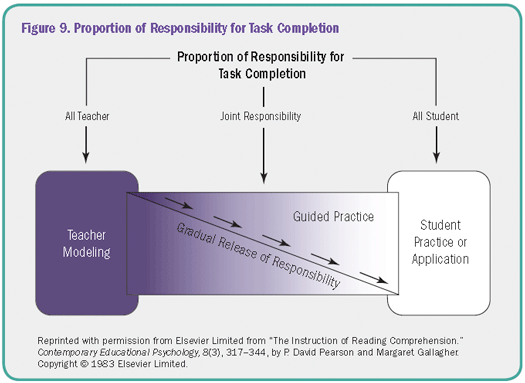The Gradual Release approach to writing instruction supports a varied approach to content, process, and product over the course of a unit or semester. Learner diversity is embraced by supporting interests, learning profiles, and readiness. Gradual Release is a way to apply differentiated instruction principles to writing instruction as the responsibility for independent writing shifts to the learners as illustrated in Figure 9.

Voices of Teachers Reflecting on This Graphic
I will hang this model in my classroom as it is a great reminder to me as a teacher and my students as a learner/teacher. —Deborah DeSousa, Rhode Island TEAL Team
I currently have the pyramid posted by my desk as a reminder to myself. Deborah shared that she has hers posted in the classroom. When I return to work tomorrow, I will be moving the pyramid! What was I thinking keeping it all to myself?! —Shannon Schaben, Nebraska TEAL Team
In the past when working with writing groups, I did a lot of modeling and collaborative work on organization as that was the first roadblock. Then generally, I let students work independently on writing their essays. Next, I would work with each student individually to discuss good parts and parts needing additional work. I really like the graphic on transferring responsibility and see now that I need to work more on the intermediate steps. —Sue Pohlman, Nebraska TEAL Team
Gradual Release is not a linear sequence; you cycle through the approaches multiple times as you start new topics or address knowledge gaps. Consult Tables 4–8 to find instructional activities to fit your various teaching goals.
Oral Language and Dialogue
Getting adults ready to write is a step not to be skipped. Prewriting engages learners in activities designed to help them generate or organize ideas for writing a first draft. This process improves the quality of their writing. Spend time with discussion, dialogue, vocabulary, and critical thinking. (Find more ideas in the Get Ready section).
Purpose: Prepare students to write
- Activate background knowledge.
- Clarify thinking and arguments on a topic.
- Make connections between speech and print.
- Generate works appropriate to a topic.
Level of Support and Role of Instructor: Extensive
- Elicit and model thinking, critique, and language.
Examine Writing Together: Modeling and Guided Practice
Dive into writing and study various aspects. Make learners’ and others’ writing an object of study. Use the cloze technique to highlight different syntactic elements depending on learners’ writing development. Use sentence combining for various levels of improvement and revision (See the Combine Sentences section). Assign written summaries from common readings that can illustrate various ways to write on the same topic (See the Teach Summarization section).
Purpose: Work with words, sentences, and paragraphs to build fluency with syntax
- Cloze exercise
- Sentence combining
- Summaries
Level of Support and Role of Instructor: Modest
- Provide criteria and timeframe for writing; lead discussion on answers and reasons.
Collaboration
Have learners work in pairs or small groups to generate writing based on class discussions. This approach reinforces the oral to written language connection as learners articulate to each other how to express an opinion, an argument, or a stance and provides an immediate authentic audience. Use peer learning to reinforce self-regulated strategy development, having learners work together on a shared strategy sequence. (Find more ideas in the Teach Self-Regulated Strategy Development section. Learn more about the importance of collaboration in the Get Ready section).
Purpose: Compose collaborative written messages based on group discussion
- Peers work in pairs to draft a single document.
- Individuals work independently but collaboratively plan, outline, share drafts, edit, and/or revise.
Level of Support and Role of Instructor: Significant to moderate
- Teacher or student leader works with small group to discuss and scaffold conversation into writing.
Independent Writing
This is the goal! Leading adult writers through the process of critical thinking, organizing their thoughts, planning, and outlining an essay leads to their actual independent writing. This does not mean that there is no role for the instructor, however. Continue to scaffold, remind learners of strategies and techniques they’ve learned, and help them use technology productively. Providing frames and models helps writers get started in a new structure, such as an academic essay or assignment. Academic sentence starters can be used first for Quick Writes or writing-to-learn prompts to help learners feel more comfortable with them. Move to using frames to get started with independent essays. Find more ideas in the Make Use of Frames section. Make your feedback to writers timely, specific, and task-oriented. Find more ideas in the Provide Constructive Feedback section and Use Technology Effectively section.
Table 7. Independent WritingPurposeLevel of Support and Role of InstructorCreate original texts that are authentic, wellcrafted, and accurate.Minimal
- Learn writing genres’ structures, templates or models, and academic vocabulary.
- Use templates or advance organizers.
- Conference with instructor to talk about writing goals.
- Provide models, demonstrate structure, and discuss embedded vocabulary and timeframe for writing.
- Use assistive and accessible technology to support the actual spelling, transcription, revision, and proofreading.
Reference
Fisher, D., & Frey, N. (2008). Better learning through structured teaching: A framework for the gradual release of responsibility. Alexandria, VA: ASCD.